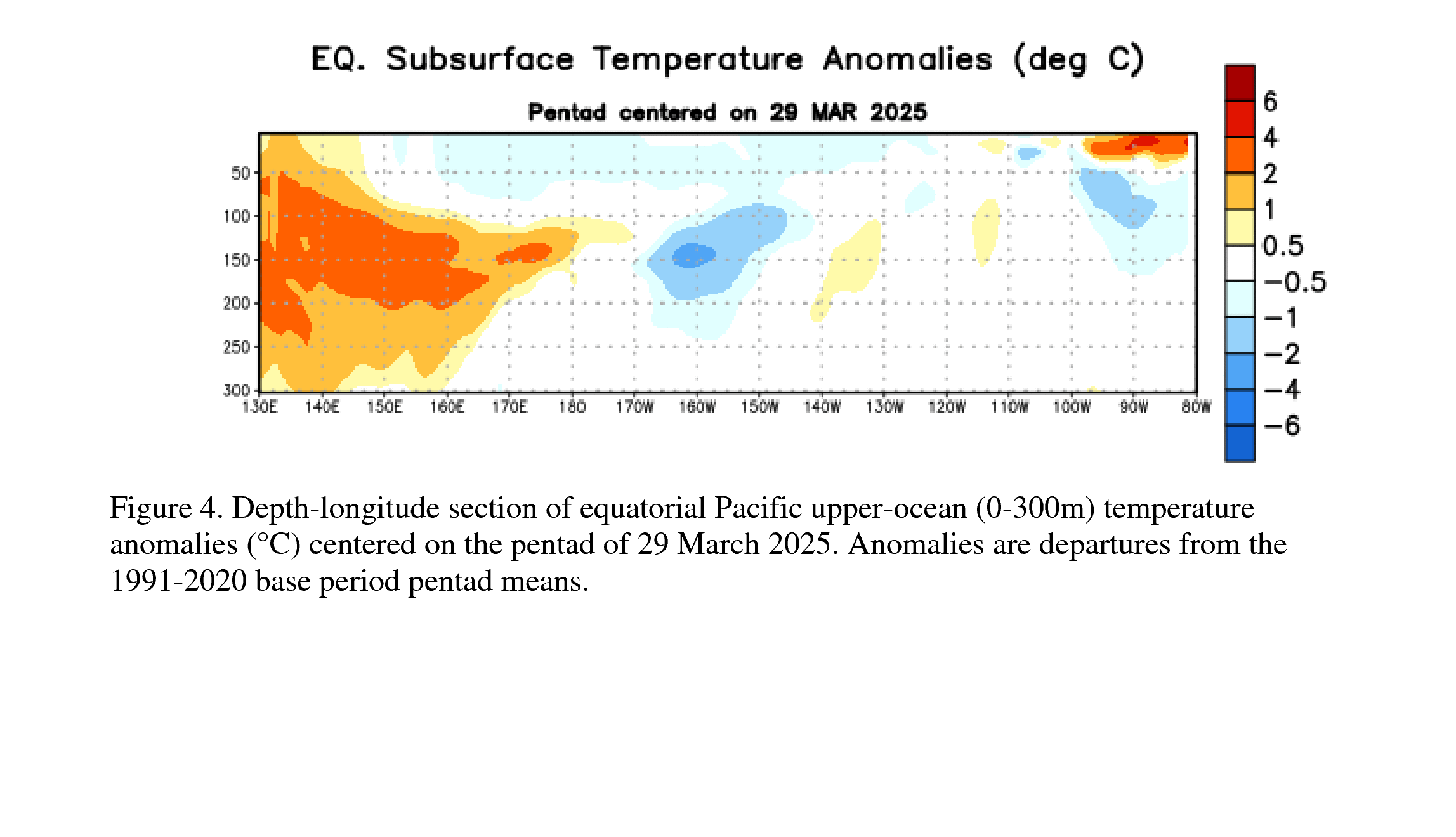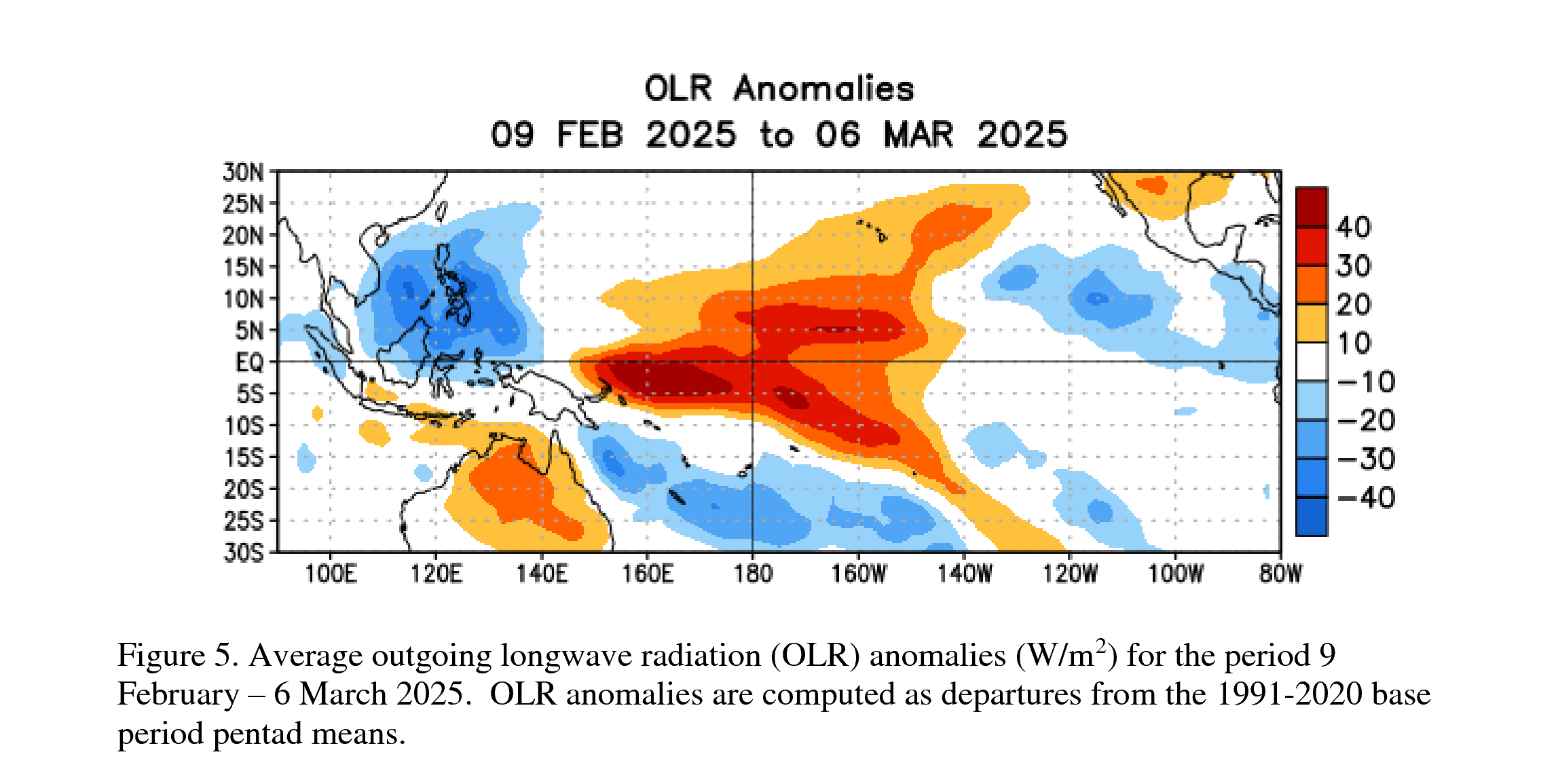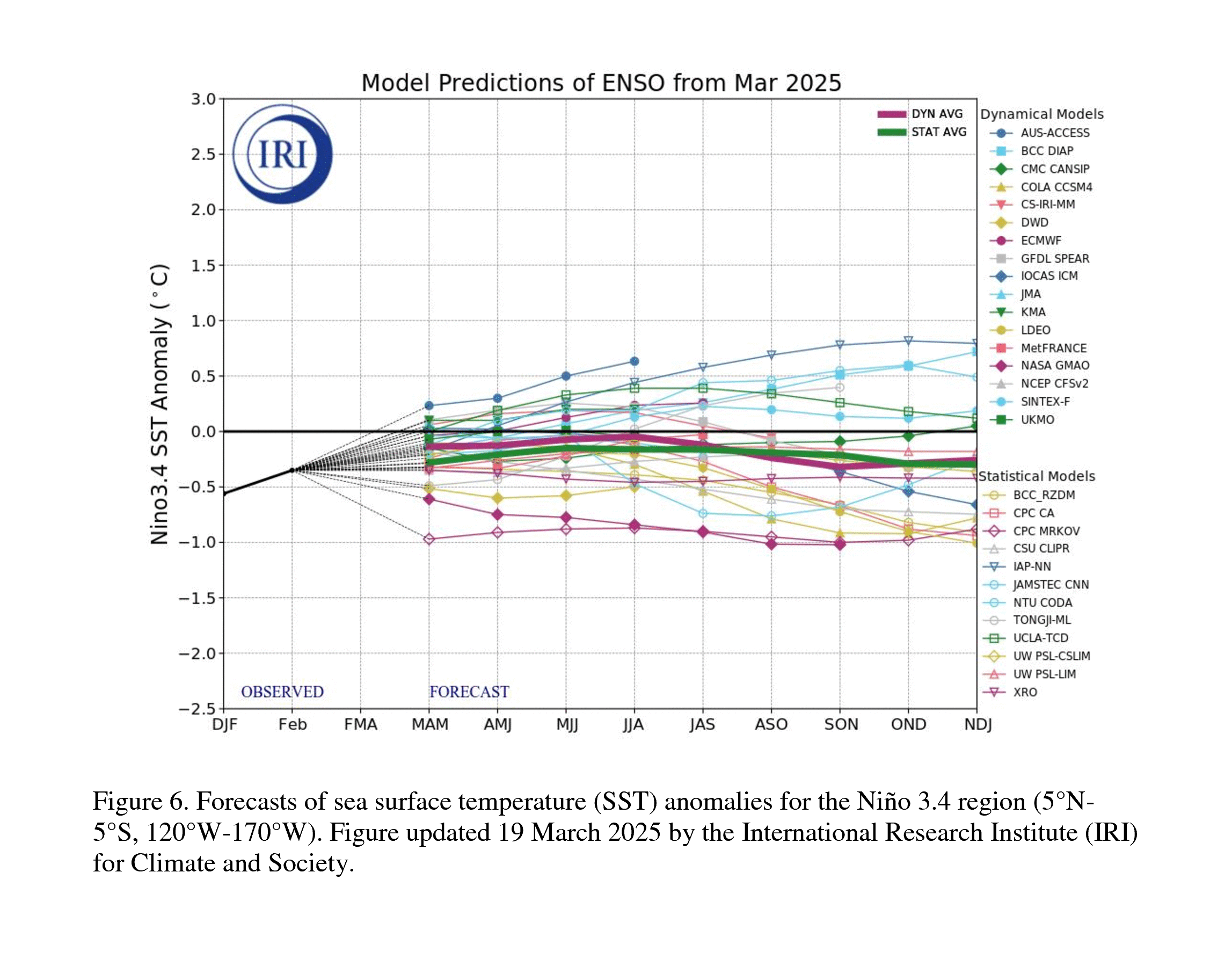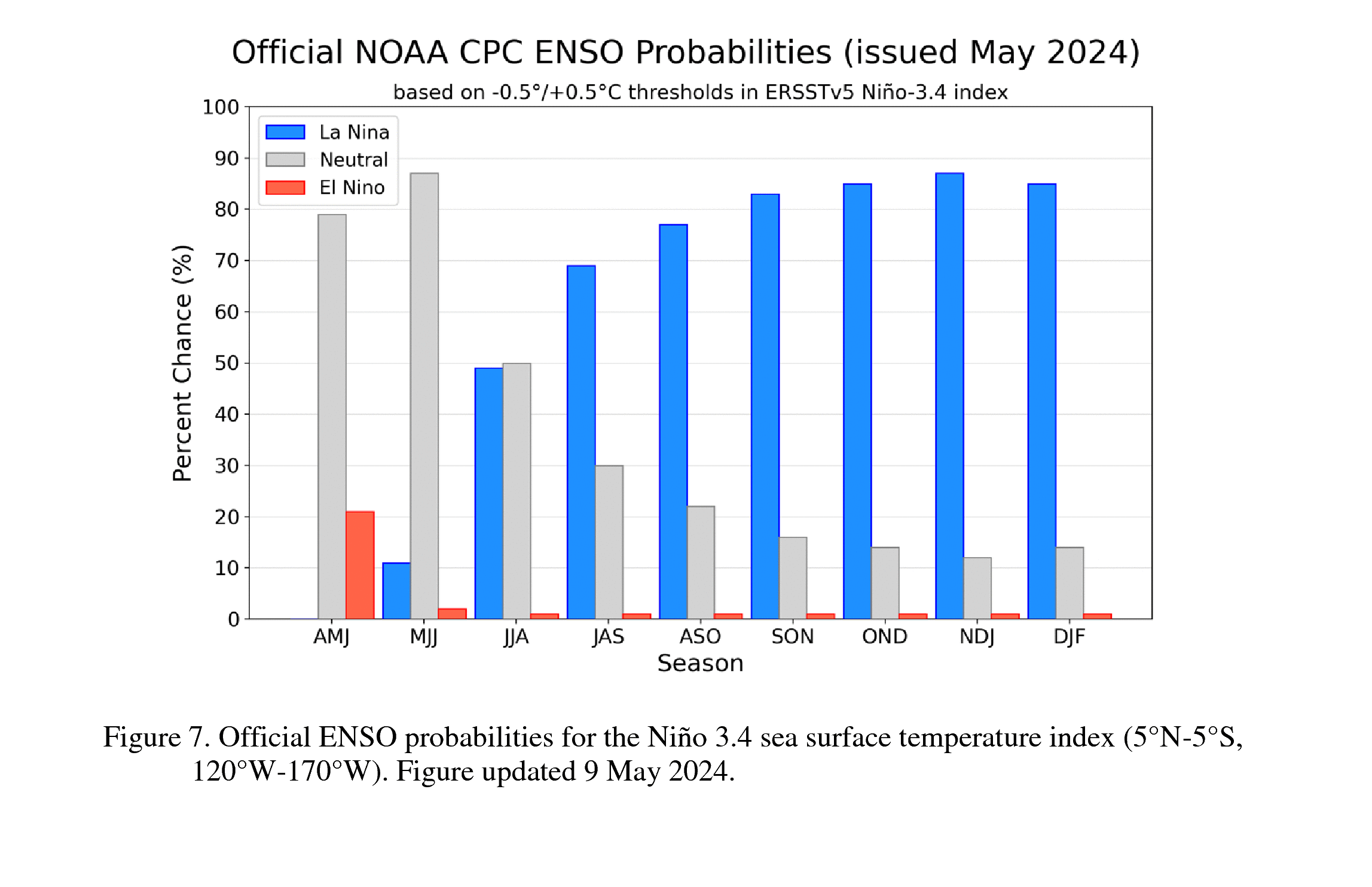IRI ENSO Forecast
IRI Technical ENSO Update
Published: January 15, 2015
Recent and Current Conditions
The SST anomaly in the NINO3.4 region has been at the weak El Niño level from mid-October to the end of December, and even reached the borderline of moderate El Niño for a single week at the end of November. For December the average NINO3.4 SST anomaly was 0.78 C, indicative of weak Niño conditions, and for Oct-Dec it was 0.71 C. The IRI’s definition of El Niño, like NOAA/Climate Prediction Center’s, requires that the SST anomaly in the Nino3.4 region (5S-5N; 170W-120W) exceed 0.5 C. Similarly, for La Niña, the anomaly must be -0.5 C or less. The climatological probabilities for La Niña, neutral, and El Niño conditions vary seasonally, and are shown in a table at the bottom of this page for each 3-month season. The most recent weekly SST anomaly in the Nino3.4 region was 0.4 C, in the category of warm-neutral for SST. This was the first week since mid-October that the SST was below 0.5 C. Accompanying this SST mainly above the El Niño threshold has been an atmospheric pattern with inadequate indication of an El Niño-like pattern–very weak westerly low-level wind anomalies and no positive anomalies of convection near the dateline. Some indicators, however, such as the Southern Oscillation Index (SOI), have been somewhat indicative of weak El Niño, and the upper level wind anomalies have also been showing El Niño-indicative enhanced easterlies.
Expected Conditions
What is the outlook for the ENSO status going forward? The most recent official diagnosis and outlook was issued earlier this month in the NOAA/Climate Prediction Center ENSO Diagnostic Discussion, produced jointly by CPC and IRI; it called for a 50-60% likelihood for El Niño conditions during January and February, followed by a greater than 50% chance for ENSO-neutral beginning in March. The latest set of model ENSO predictions, from mid-January, now available in the IRI/CPC ENSO prediction plume, is discussed below. Currently, Nino3.4 SST anomalies are near the borderline of warm-neutral and weak El Niño conditions. Subsurface temperature anomalies across the eastern equatorial Pacific have remained above average, but have weakened considerably during December and the first half of January. In the atmosphere, the basin-wide sea level pressure pattern (e.g. the SOI) has been weakly negative (in neighborhood of -0.5) over the last month, suggestive of borderline El Niño conditions at best. Also, other atmospheric parameters continue to reflect neutral ENSO conditions: Weak anomalous low-level westerlies have only appeared at times during the last month or two, but interestingly have recently appeared in the western tropical Pacific and could potentially induce a weak downwelling Kelvin wave that might reinforce some warming at the surface in the coming few months. Upper level anomalous easterly anomalies have been observed over part of the equatorial Pacific, indicative of El Niño, but have been less clear in recent weeks. But perhaps more importantly, anomalous convection (as measured by OLR) has been near average, or even below average, near and eastward of the dateline. Together, the oceanic and atmospheric features reflect a warmish but neutral ENSO condition, despite the clearly weak El Niño status of the SST (except for the very latest week) during the last nearly three months.
As of mid-January, none of the dynamical or statistical models models predicts La Niña SST conditions for the initial Jan-Mar 2015 season, 74% predicts El Niño conditions, and 26% indicates neutral ENSO. At lead times of 3 or more months into the future, statistical and dynamical models that incorporate information about the ocean’s observed subsurface thermal structure generally exhibit higher predictive skill than those that do not. For the Apr-Jun 2015 season, among models that do use subsurface temperature information, 72% predicts El Niño SST conditions, 28% predicts ENSO-neutral conditions and none predicts La Niña conditions. For all model types, the probabilities for El Niño are 61% for Feb-Apr, between 50% and 60% between Mar-May and May-Jul, and drop to below 50% from Jun-Aug until the final forecast season of Sep-Nov. No model predicts La Niña conditions for any of the 3-month periods between Jan-Mar and Aug-Oct 2015, but 6% of the models (i.e., one model) predicts La Niña conditions for Sep-Nov.
Note – Only models that produce a new ENSO prediction every month are included in the above statement.
Caution is advised in interpreting the distribution of model predictions as the actual probabilities. At longer leads, the skill of the models degrades, and skill uncertainty must be convolved with the uncertainties from initial conditions and differing model physics, leading to more climatological probabilities in the long-lead ENSO Outlook than might be suggested by the suite of models. Furthermore, the expected skill of one model versus another has not been established using uniform validation procedures, which may cause a difference in the true probability distribution from that taken verbatim from the raw model predictions.
An alternative way to assess the probabilities of the three possible ENSO conditions is more quantitatively precise and less vulnerable to sampling errors than the categorical tallying method used above. This alternative method uses the mean of the predictions of all models on the plume, equally weighted, and constructs a standard error function centered on that mean. The standard error is Gaussian in shape, and has its width determined by an estimate of overall expected model skill for the season of the year and the lead time. Higher skill results in a relatively narrower error distribution, while low skill results in an error distribution with width approaching that of the historical observed distribution. This method shows probabilities for La Niña near 0% from Mar-May 2015 through Apr-Jun, rising to 6% by Jun-Aug and up to 20% by Sep-Nov. Model probabilities for neutral ENSO conditions are 36% for the initial period of Mar-May 2015, 42% for the next running period of Feb-Apr 2015, between 44% and 47% between Mar-May and Jul-Sep and near 40% for Aug-Oct and Sep-Nov. Probabilities for El Niño are 64% for Jan-Mar 2015, 58% for Feb-Apr, and slowly decrease from 55% to 50% from Mar-May to Jun-Aug. After Jun-Aug, probabilities for El Niño drop through the 41% to 47% interval through the final season of Sep-Nov. The models collectively favor El Niño over other ENSO conditions by a large margin only for Jan-Mar 2015. A plot of the probabilities generated from this most recent IRI/CPC ENSO prediction plume using the multi-model mean and the Gaussian standard error method summarizes the model consensus out to about 10 months into the future. The same cautions mentioned above for the distributional count of model predictions apply to this Gaussian standard error method of inferring probabilities, due to differing model biases and skills. In particular, this approach considers only the mean of the predictions, and not the total range across the models, nor the ensemble range within individual models.
The probabilities derived from the models on the IRI/CPC plume describe, on average, El Niño conditions for the Jan-Mar 2015 season currently in progress, likely enduring well into northern spring season of 2015. The consensus of model predictions calls for a weak El Niño event, as already seen in the SST anomalies over the last two to three months. A caution regarding this latest set of model-based ENSO plume predictions, is that factors such as known specific model biases and recent changes that the models may have missed will be taken into account in the next official outlook to be generated and issued in early October by CPC and IRI, which will include some human judgement in combination with the model guidance.
Climatological Probabilities
| Season |
La Niña |
Neutral |
El Niño |
| DJF |
37% |
28% |
35% |
| JFM |
34% |
37% |
29% |
| FMA |
30% |
48% |
22% |
| MAM |
26% |
54% |
20% |
| AMJ |
24% |
54% |
22% |
| MJJ |
25% |
51% |
24% |
| JJA |
25% |
50% |
25% |
| JAS |
27% |
46% |
27% |
| ASO |
29% |
40% |
31% |
| SON |
32% |
34% |
34% |
| OND |
34% |
31% |
35% |
| NDJ |
37% |
27% |
36% |
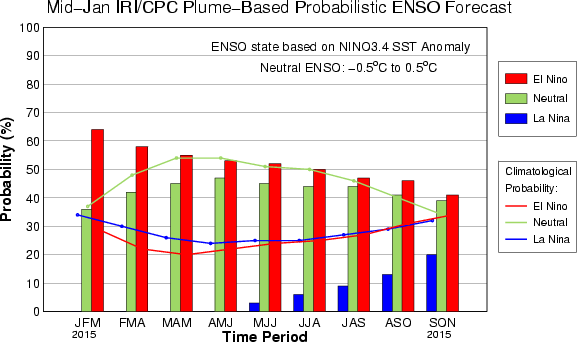
IRI/CPC Mid-Month Plume-Based ENSO Forecast Probabilities
| Season |
La Niña |
Neutral |
El Niño |
| JFM 2015 |
~0% |
36% |
64% |
| FMA 2015 |
~0% |
42% |
58% |
| MAM 2015 |
~0% |
45% |
55% |
| AMJ 2015 |
~0% |
47% |
53% |
| MJJ 2015 |
3% |
45% |
52% |
| JJA 2015 |
6% |
44% |
50% |
| JAS 2015 |
9% |
44% |
47% |
| ASO 2015 |
13% |
41% |
46% |
| SON 2015 |
20% |
39% |
41% |







